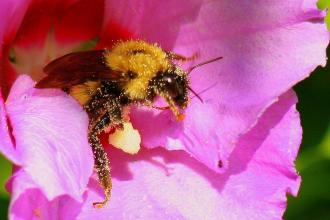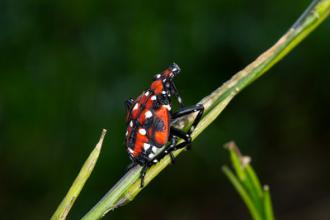
Insects have segmented bodies, legs with joints, and external skeletons, called exoskeletons. They are the only winged invertebrates (animals without backbones), though not all insects have wings. Flight helps ensure success in colonizing, creating new habitats and pollinating.
Pollinators move pollen from the stamen, the male part of the flower, to the stigma, the female part of the same flower. Pollinators include bees, wasps, birds, butterflies, moths, flies and even some small mammals, including bats. Pollinators help about 80% of the world's flowering plants to reproduce.
On this page, find information about the roles of insects, beekeeping and pollination, invasive species, and links to scientific data sets.
Featured Resources
Beekeeping

There are many insect pollinators. Farmers and hobbyists use bees, for example, to operate a variety of enterprises including production of beeswax, honey and other edible bee products; crop pollination services; and the sale of bees to other beekeepers.
Invasive Terrestrial Invertebrates

Insects are the most common invasive terrestrial invertebrate, an animal that lacks a vertebral column (backbone). The National Invasive Species Information Center (NISIC) develops species profiles that provide general information about species considered to be invasive.
i5K Workspace@NAL

The National Agricultural Library's i5k Workspace@NAL is a platform for communities around 'orphaned' arthropod genome projects to access, visualize, curate and disseminate their data.
The Roles of Insects in Agriculture
-
Search the Department of Entomology Collections
Smithsonian National Museum of Natural History.
-
Beneficial Insects
National Pesticide Information Center.
Not all bugs are bad! Insects are considered pests because they cause harm to people, plants, animals, and buildings. Of nearly one million known insect species,less than three percent are considered pests. What about the rest of them? Some insects actually keeping the harmful ones at bay.
-
Systematic Entomology Laboratory
USDA. Agricultural Research Service.
The Systematic Entomology Laboratory is responsible for the identification of insect specimens. Collects research projects, publications, collaborations, news, and videos.
-
Common Names of Insects Database
Entomological Society of America (ESA).
The ESA Database contains more than 2,000 common names. It's searchable by common name, scientific name, author, order, family, genus, and species.
-
Pollinators
USDA. U.S. Forest Service.
A collection of information on insect and animal pollinators, pollinator-friendly practices, pollination strategies, gardening and more.
-
Identification Technology Program (ITP)
ITP is part of USDA. APHIS Plant Protection and Quarantine (PPQ).
Find tools to identify invasive insects, mites, snails and slugs, diseases, and weeds.
Pollinators

Pollinators play a critical role in agriculture. Access USDA Pollinator Offices and Initiatives, and External Federal Pollinator Partners. Find pollinator research and data, information, media, tools, grants, and other resources.
Pollinators in Agriculture
-
Gardening for Pollinators
USDA. Forest Service.
-
How to Build a Pollinator Garden
DOI. U.S. Fish and Wildlife Service.
-
Planting for Pollinators
USDA. Agricultural Research Service.
The Pollinator Garden at the ARS in Beltsville, Maryland "is an educational tool showing a real-life example of the codependent nature of our food ecosystem and the value pollinators provide to it."
-
Working for Trees
U. S. Forest Service and USDA. Natural Resources Conservation Service.
More than 100 crop species in North America need the help of pollinators to reproduce successfully. This brochure explains how agroforestry (the cultivation of trees) can be developed to assist pollinators.
Search PubAg
Ask an Expert
Ask your local Extension Service Office for information and resources on insects and pollinators.
 An official website of the United States government.
An official website of the United States government.